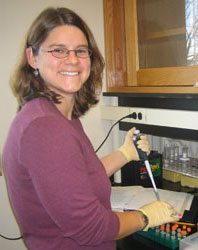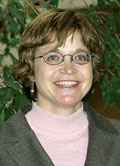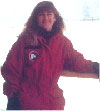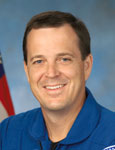
 |
| OCEANS HOME>PROSPECTIVE STUDENTS |
|
| Oceanography at USM grants masters and PHD degrees. Undergraduates may learn about oceanography through elective courses. Students may be enrolled in one of many departments or the MEES cross-institution programs and pursue a degree in oceanography. Generally students enroll in the department of their advisor. If you are interested in applying to graduate school in oceanography, contact several faculty members to learn about their research programs, and to determine whether they mesh with your own. In most departments, students must have an advisor willing to mentor them in order to be admitted. |
 Carrie Solomon, a former PhD student from MEES, studies with Dr. Patricia Glibert at UMCES/HPL. Her research interests include nitrogen cycling, urease and nitrate reductase activity, relationships between the presence of genes and expression of functional group genes. She is also on the faculty at Gallaudet University. |
If you are interested in Oceanography graduate school at the Masters or PhD level, consider applying to one of our degree granting programs. MEES: The Marine Estuarine, Environmental Sciences graduate program serves as the primary graduate program for faculty at UMCES, UMES, and UMBI/COMB, faculty at UMBC and UMCP also participate. Oceanography foci: restoration ecology, fisheries oceanography, biological, physical, geological and chemical oceanography, marine biotechnology, toxicology, environmental chemistry and remote sensing. Apply to MEES AOSC: The Department of Atmospheric and Ocean Science at College Park. Oceanography foci: atmospheric chemistry, climate studies, data assimilation, glaciology, physical oceanography, and remote sensing. Apply to Graduate School at the University of Maryland DGeog: The Department of Geography at College Park. Oceanography foci: emphasis on human dimensions, physical systems, and geographic methods. Apply to Graduate School at the University of Maryland DGeol: The Department of Geology at College Park. Oceanography foci: Earth's surface processes, including hydrology, sedimentation, geomicrobiology, geomorphology, remote sensing and environmental change. Apply to Graduate School at the University of Maryland CEE: The Department of Civil and Environmental Engineering at UMBC. Oceanography foci: Water quality, Water resources systems analysis, Watershed hydrology, Groundwater transport Environmental risk assessment, Sediment geochemistry, Contaminant bioavailability. Apply to Gradutate School at UMBC |
|
|
Past students in oceanography at University System of Maryland have gone on to private industry, and state and federal government jobs, as well as teaching and research oriented faculty positions within universities. Some past students that illustrate a variety of career paths include: |
|||
 |
John Heidelberg, a former PhD student from the MEES program, worked with Rita Colwell at UMBI/COMB. He now is an Associate Professor at the University of Southern California, where he continues research on genome sequencing. |
 |
Abby Schneider (MEES August 2005 Ph.D. under Dr. Joel Baker, UMCES/CBL) is currently an American Chemical Society Congressional Fellow working in the office of Senator Dianne Feinstein. Abby focuses on water issues, including perchlorate contamination, fisheries, endangered species and climate change. |
 |
Debbie Bronk, a former PhD student from the MEES program, worked with Pat Glibert at UMCES/HPL on dissolved organic nitrogen. She is now an associate professor at the Virginia Institute of Marine Science, where she is interested in the fluxes of nitrogen in open ocean, coastal, and estuarine environments with emphasis on the role of dissolved organic nitrogen (DON) in microbial food webs. |  |
USM alumni Richard Arnold II, who has become one of NASA's newest astronauts has a master's degree from the University of Maryland MEES Program. From the press release: "Richard Arnold II, mission specialist-educator. Arnold, a math and science teacher who has taught in places ranging from Morocco to Romania. He most recently taught math and science at the American International School in Bucharest, Romania." |